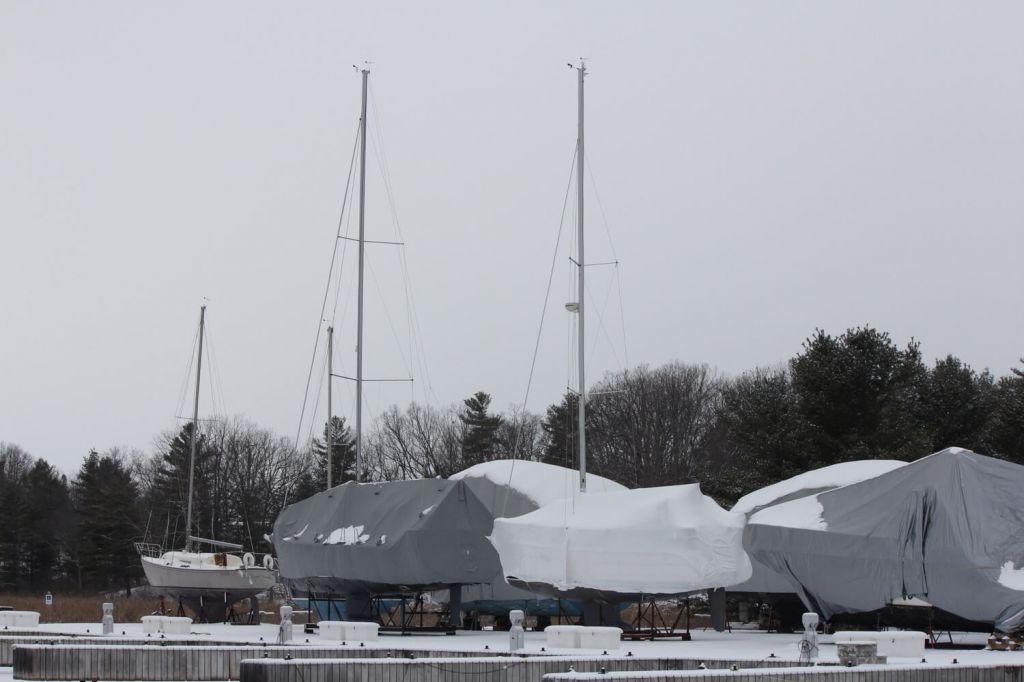The Average Cost to Shrink Wrap a Boat (per foot)
Protecting your boat when it is stored somewhere should be your top priority. In case you opt for shrink wrap, this article talks about how much that will cost you so that you can decide if you are getting your money's worth.
So what is the average cost to shrink wrap a boat per foot?
- For powerboats, it will cost between $12 - $25 per foot on average
- For sailboats, it will cost between $12 - $25 per foot on average
- For sailboats, expect a $2 - $3 dollar price increase if you leave the mast up.
Cost of optional wrapping features:
- Anti-moisture bags: $8 each
- Adding an entrance: $30 - $40
- Anti-mold spray typically costs an additional $50
- Vents for mold protection cost on average $4 each
- Shrink-wrapping a boat in the water costs on average $100 - $150 extra

Pros and Cons of Shrink Wrapping a Boat - Worth It?
Let me break these numbers down a bit so that you know what you are paying for and if there are ways to make this cost less. Or more. Whatever floats your boat.
Before I do that though, let me point out that I am just talking about reasonable prices here. Of course, you might find a company that will do the job for one-quarter of the price if they are just starting up and the discount will be a part of their promotion.
Or if you stumble upon a crafty person who does this on their own out of their garage, their price list will look more friendly than the costs I specify here, meaning they could make you an offer as low as 8 dollars per foot.
Similarly, you might find unreasonably high prices, justified by whatever the specific businessman can use as a good rationale to spice up the bill.
There's a huge price range, and the prices mentioned here should provide a guideline as to what is reasonable to expect.

Winterize Your Boat

On this page:
Cost Influencing Factors
First of all, let me explain why there is such a large price per foot spread. Mainly, this is because there are several factors that influence the final price, meaning the length itself is not the only determinant of what you will have to pay.
Factors that will influence the cost:
- length of the boat
- deck hardware and other unusual shapes
- extras like an entrance in your shrink-wrap
- trailered or not?
- insured or not?
Beam
The most obvious reason for the price spread is that the longer the boat, the wider it is. Regardless of whether we are talking about a cruiser or a racer, it makes sense that a twenty feet boat will have a smaller beam than a fifty footer. Thus the price per foot exponentially increases as does the boat length.
So if your boat is around the twenty to thirty feet mark, the price will start at approximately 12 dollars per foot. If you have a fifty footer, the price per foot will likely be around 25 dollars.
Towers, Fly Bridges, Masts
Then you gotta think about all the stuff on top of your boat. It only makes sense that a boat with a T-top will need extra material and work to get wrapped up, compared to a speedboat that has everything non-aerodynamic 'shaved off'.
The same goes for a mast. Although you won't be shrink-wrapping the whole thing from the bottom all the way to the mast top, (but you can if you want, whoever will do your shrink wrapping will be happy for the extra business) the wrap has to go around the mast bottom and that is more work than if the mast was not there. If you take your mast down, you don't have to worry about a price increase, but if you leave it up, add around 2 or 3 dollars extra per foot.
Extras
There are a few extras you can have added on top of your standard shrink-wrap job. We aren't talking about unnecessary luxuries, some of them make a lot of sense. One such thing is an entrance to your shrink-wrapped boat. Quite often people want to be able to access the boat's interior while it is wrapped, for instance, to be able to do some repairs. Or for a sleepover, since they can't get enough of their beloved vessel. That's a possible 30 to 40 extra dollars to your bill.
Or if your boat has a large cabin, you might want to put in more moisture bags, which will also raise the overall cost. Expect around 8 dollars per one.
Sometimes the shrink wrap company will offer to store your canvas and glass panels - again, potential cost increase.
And sometimes, you might get offered an anti-mold protection spray down (not a bad idea if you ask me), which can easily cost you fifty extra bucks.
To continue along the same lines - you might also want to add vents to the shrink wrap, expect to pay approximately 4 dollars for each. A small price to pay for mold prevention.
For those of you who want to shrink wrap a boat that is sitting in the water - although that is entirely possible, it might cost you approximately between 100 and 150 dollars more.
Trailers
This will only apply to the smaller boats, but it is well worth the mention - if your boat will not sit in one place during the offseason and you plan to move it around on a trailer, go for what is referred to as a 'bullet wrap'. It is similar to a traditional wrap but is made of a material that endures more and thus you can take it to the highway.
Insurance…
...is not a bad idea since open flame, as well as highly flammable materials, are involved in a shrink wrapping session. A professional shrink wrapper will be insured, which gives you the extra feeling of safety and a few extra bucks on top of the quote.
Trash Disposal
Last but not least, when you take the shrink wrap down once you are ready to get back on the water, you need to dispose of it. Your usual trash can will not do since we are talking about tens (hundreds) of square feet of plastic. Many shrink wrapping companies will take the stuff off your hands. For a price.

Can You Recycle or Reuse Boat Shrink Wrap? (and How To Do It)
Sailboat vs Powerboat?
Though I have touched upon this a bit already, let's see if a sailboat shrink wrap will cost you more than a powerboat. A quick hint - it doesn't have to, but you have to take the mast down. If you do not want to or can not do so, you will see the aforementioned 2 - 3 dollar per foot price increase. You don't have to worry about the keel, shrink wrap does not actually cover the whole boat. It does not go all the way down, thus however large your keel might be, this will not influence the price.
Speaking of shrink wrap going all the way down - some companies will only wrap your boat down to the rub rail to save on the material costs. Make sure they wrap it all the way to the sides of the hull.
Can You Do It Yourself Instead?
With all these costs piling up, is it not worth it to simply do it yourself? After all, you can easily get all the 'ingredients' online and the mighty internet has all the how-to guides ranging from building bombs to boiling water in a kettle, (not kidding) so a shrink wrapping manual is easy to find.
Let's put aside the hazard stemming from an open flame close to your boat and potential mishaps stemming from the lack of expertise. A propane bottle rental might cost you around 70 dollars, a roll of shrink wrap sheet around 200 dollars. The rest, like a knife, good tape, adhesive, supports, sharp corner protection, and willing helpers might be available in your home for free(ish). So, in the end, it is up to you to compare a quote from a professional with your DIY calculation and do a reasonable estimation.
More often than not you will realize that unless you can pair up with a few other boating friends and plan to do this every year, a professional is the most cost-effective choice here.
Why Even Do It?
Maybe you think that both the professional and DIY costs are too much and not worth the investment. So let me summarize what shrink wrap is good for so that you can decide if you want to go ahead with the purchase or not.
Shrink-wrap quite simply protects your boat from rain, UV rays and, if you live in a cold area, snow. Plus it does so in a way that after you are done with it, there is no extra maintenance needed.
If you for instance just covered your boat with a large plastic sheet, it might tear as the wind hits it for weeks on end, it might not withstand the sun, temperatures or the weather abuse. Plastic sheets also tend to create pockets under pressure in which snow or rain might pool. A shrink wrap is much tighter than what you would achieve with some plastic sheets and tape.
But then again, if your boat sits in your backyard, you can stick to plastic sheets, provided you can and don't mind checking it every few days. Which would push your cost to just a few dollars.
And if you are lucky enough to have a garage or a shed for your boat, one that mice can not get in, you can round the shrink wrapping costs to a nice zero.
For a full pros and cons list, check out William's article discussing whether shrink wrapping your boat is ultimately worth it.
Did you find the answer to your specific question?
👍 10 👎 3



Leave a comment